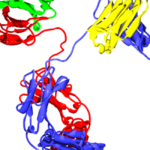1. The median progression free survival for all cancer-types was 2.8 months.
2. Most of the adverse events (AEs) were mild; most commonly rash and increased aspartate aminotransferase, however, there was 1 treatment related death.
Evidence Rating Level: 2 (Good)
Study Rundown: Antibody drug conjugates (ADCs) are targeted cancer therapeutics comprised of a cytotoxic medication combined with a monoclonal antibody. MRGOO3 is an ADC containing an antibody against epidermal growth factor receptor (EGFR), which is overexpressed in some solid tumours, including colorectal cancer (CRC), nasopharyngeal carcinoma (NPC), and squamous cell carcinomas of the head and neck (SCCHN). This study had two groups of patients in which it explored the impact of MRGOO3 on advanced or metastatic solid tumours; those with no prior EGFR screening (phase 1a; the escalation group) and those who were EGFR-positive (phase 1b; the expansion group). In phase 1a, outcomes included dose-limiting toxic effects. In phase 1b, outcomes were progression free survival (PFS) and duration of response (DOR). Secondary outcomes included safety profile as measured by adverse events (AEs). A single dose-limiting toxic effect of febrile neutropenia and bacterial pneumonia was seen in the group receiving 2.5mg/kg. In the expansion group, median PFS for all cancer types was 2.8 months. PFS for CRC was 1.2 months, for SCCHN was 2.8 months, and for NPC was 4.0 months.
The median DOR for patients in the phase 1b cohort was 5.6 months. The majority of adverse events (AEs) were mild and the most common were increased aspartate aminotransferase (AST) levels and rash. 89% of AEs were associated with MRGOO3. In the phase 1a cohort, one patient had a severe AE associated with MRGOO3 treatment that resulted in death. Limitations to this study include the limitations of early phase studies include small sample size and a single arm study. Overall, treatment with MRGOO3 was associated with positive outcomes in EGFR expressing cancers that warrants further investigations.
Click to read the study in JAMA Oncology
Relevant Reading: Review on epidermal growth factor receptor (EGFR) structure, signaling pathways, interactions, and recent updates of EGFR inhibitors
In-Depth [prospective cohort]: This 2-phase, non-randomized, single arm study conducted in multiple centres recruited 61 patients with advanced or metatstatic solid tumours. Phase 1a included 22 patients who had not had EGFR prescreening, while phase 1b was comprised of 39 EGFR-positive CRC, NPC, and SCCHN patients. The dose escalation progressed from an initial dose of 0.1mg/kg, then to 0.3, 0.6, 1.0, 1.5, 2.0, and 2.5mg/kg. Patients in both groups were treated every 3 weeks, up to 8 cycles. In phase 1a, dose-limiting toxic effects were the outcome of interest. In phase 1b, outcomes included progression free survival (PFS) as well as duration of response (DOR). Safety profile was a secondary outcome, measured by adverse events (AEs). A single dose-limiting toxic effect of febrile neutropenia and bacterial pneumonia was seen in the group receiving 2.5mg/kg. In the expansion group, the median PFS for all cancer types was 2.8 months (95% confidence interval (CI), 1.2-4.1 months). PFS for CRC was 1.2 months (95% CI, 0.5-2.8 months), for SCCHN was 2.8 months (95% CI, 0.6-6.8 months), and for NPC was 4.0 months (95% CI, 1.2-not reached). The median DOR for patients in the phase 1b cohort was 5.6 months. The DOR for SCCHN was 5.6 months; 95% CI, 2.8-5.6 months, and was not estimable for NPC. Most AEs were associated with MRGOO3, and included both rash and increased AST levels, at 39% each. One severe treatment-related AE resulted in the death of a patient from phase 1a.
Image: PD
©2022 2 Minute Medicine, Inc. All rights reserved. No works may be reproduced without expressed written consent from 2 Minute Medicine, Inc. Inquire about licensing here. No article should be construed as medical advice and is not intended as such by the authors or by 2 Minute Medicine, Inc.


